今天我们来使用一下
安卓五大布局
安卓五大布局分别是 线性布局 相对布局 绝对布局 表格布局 帧布局
1.LinearLayout 线性布局:
属性1:水平或者垂直排列
属性2:子视图不可能重叠
线性布局有一个特有的方法oritation来设置它的方向
oritation 有两种方向 垂直方向vertical和水平方向horizontal
还有一个来分配剩余空间的方法 weight
下面我们来使用一下
<?xml version="1.0" encoding="utf-8"?> <LinearLayout xmlns:android="http://schemas.android.com/apk/res/android" xmlns:tools="http://schemas.android.com/tools" android:id="@+id/activity_main" android:layout_width="match_parent" android:orientation="vertical" android:layout_height="match_parent" tools:context="com.example.day1.MainActivity"> <TextView android:layout_width="180dp" android:layout_height="0dp" android:background="#3CB6E3" android:text="床前明月光" android:gravity="center" android:layout_weight="3"/> <TextView android:layout_width="180dp" android:layout_height="0dp" android:text="床前明月光" android:background="#FDBA43" android:gravity="right|bottom" android:layout_gravity="right" android:layout_weight="3"/> <TextView android:layout_width="180dp" android:layout_height="0dp" android:text="床前明月光" android:background="#CA0813" android:gravity="right|top" android:layout_weight="1"/> </LinearLayout>
案例效果:

同时我们还要会熟练的运用线性布局的嵌套:
<?xml version="1.0" encoding="utf-8"?> <LinearLayout xmlns:android="http://schemas.android.com/apk/res/android" xmlns:tools="http://schemas.android.com/tools" android:id="@+id/activity_main2" android:layout_width="match_parent" android:layout_height="match_parent" android:orientation="vertical" tools:context="com.example.day1.Main2Activity"> <LinearLayout android:layout_width="match_parent" android:layout_height="0dp" android:layout_weight="1"> <Button android:text="点我" android:layout_width="0dp" android:layout_height="wrap_content" android:layout_weight="1"/> <Button android:text="点我" android:layout_width="0dp" android:layout_height="wrap_content" android:layout_weight="1"/> <Button android:text="点我" android:layout_width="0dp" android:layout_height="wrap_content" android:layout_weight="1"/> <Button android:text="点我" android:layout_width="0dp" android:layout_height="wrap_content" android:layout_weight="1"/> </LinearLayout> <TextView android:background="#CA0813" android:layout_width="match_parent" android:layout_height="0dp" android:text="布局的嵌套使用" android:textSize="20sp" android:gravity="center" android:layout_weight="10"/> <LinearLayout android:layout_width="match_parent" android:layout_height="0dp" android:layout_weight="1"> <Button android:text="点我" android:layout_width="0dp" android:layout_height="wrap_content" android:layout_weight="1"/> <Button android:text="点我" android:layout_width="0dp" android:layout_height="wrap_content" android:layout_weight="1"/> <Button android:text="点我" android:layout_width="0dp" android:layout_height="wrap_content" android:layout_weight="1"/> </LinearLayout> </LinearLayout>
案例效果:
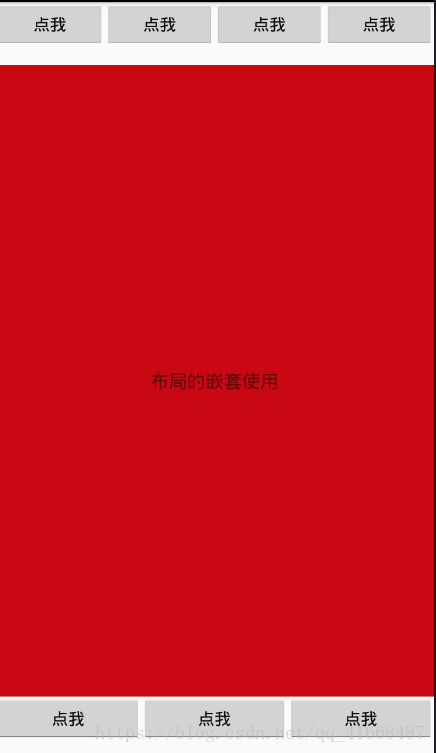
2.RelativeLayout 相对布局:
当它的参照物是父布局的时候 有以下方法可以使用
1.android:layout_alignParentLeft=true 相对于父布局在父布局的左侧对齐
2.android:layout_alignParentTop=true相对于父布局 在父布局的上侧对齐
3.android:layout_alignParentButtom=true相对于父布局 在父布局的下侧对齐
4.android:layout_alignParentRight=true相对于父布局 在父布局的右侧对齐
5.android:layout_centerInParent=true 相对于父布局居中
6.android:layout_centerVertical=true 相对于父布局垂直居中
7.android:layout_centerHorizontal=true 相对于父布局水平居中
当它的参照物是兄弟控件的时候 可以使用下列方法
1.android:layout_alignLeft=“@id/button” 参数是参照物视图的id 作用于 参照物视图左边对齐
2android:layout_alignRight=“@id/button” 参数是参照物视图的id 作用于 参照物视图右边对齐
2.android:layout_alignTop=“@id/button” 参数是参照物视图的id 作用于 参照物视图上边对齐
3.android:layout_alignButtom=“@id/button” 参数是参照物视图的id 作用于 参照物视图下边对齐
4.android:layout_toLeftof=“@id/button” 在参照物视图的 左侧
5.android:layout_toRightof=“@id/button” 在参照物视图的右侧
6.android:layout_above=“@id/button” 在参照物视图的上侧
7.android:layout_below=“@id/button”在参照物视图的下侧
我们来简单使用一下它的方法
<?xml version="1.0" encoding="utf-8"?> <RelativeLayout xmlns:android="http://schemas.android.com/apk/res/android" xmlns:tools="http://schemas.android.com/tools" android:id="@+id/activity_main" android:layout_width="match_parent" android:layout_height="match_parent" tools:context="com.example.myapplication.MainActivity"> <Button android:id="@+id/btn1" android:layout_centerInParent="true" android:text="居中" android:layout_width="wrap_content" android:layout_height="wrap_content" /> <Button android:layout_toLeftOf="@id/btn1" android:layout_alignBottom="@id/btn1" android:text="左侧" android:layout_width="wrap_content" android:layout_height="wrap_content" /> <Button android:layout_toRightOf="@id/btn1" android:layout_alignBottom="@id/btn1" android:text="右侧" android:layout_width="wrap_content" android:layout_height="wrap_content" /> <Button android:layout_alignRight="@id/btn1" android:layout_above="@id/btn1" android:text="上侧" android:layout_width="wrap_content" android:layout_height="wrap_content" /> <Button android:layout_alignRight="@id/btn1" android:layout_below="@id/btn1" android:text="下侧" android:layout_width="wrap_content" android:layout_height="wrap_content" /> </RelativeLayout>
效果图:
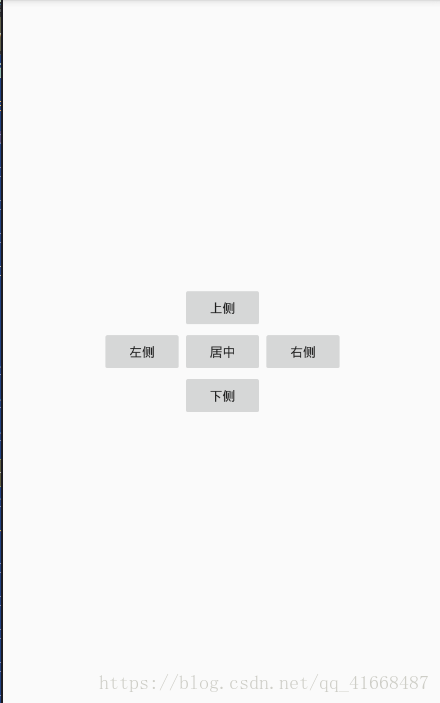
<?xml version="1.0" encoding="utf-8"?> <RelativeLayout xmlns:android="http://schemas.android.com/apk/res/android" xmlns:tools="http://schemas.android.com/tools" android:id="@+id/activity_main" android:layout_width="match_parent" android:layout_height="match_parent" tools:context="com.example.myapplication.MainActivity"> <Button android:id="@+id/btn1" android:layout_centerInParent="true" android:text="居中" android:layout_width="wrap_content" android:layout_height="wrap_content" /> <Button android:layout_below="@id/btn1" android:layout_toLeftOf="@id/btn1" android:text="左下" android:layout_width="wrap_content" android:layout_height="wrap_content" /> <Button android:layout_above="@id/btn1" android:layout_toLeftOf="@id/btn1" android:text="左上" android:layout_width="wrap_content" android:layout_height="wrap_content" /> <Button android:layout_below="@id/btn1" android:layout_toRightOf="@id/btn1" android:text="右下" android:layout_width="wrap_content" android:layout_height="wrap_content" /> <Button android:layout_above="@id/btn1" android:layout_toRightOf="@id/btn1" android:text="右上" android:layout_width="wrap_content" android:layout_height="wrap_content" /> </RelativeLayout>
效果图:
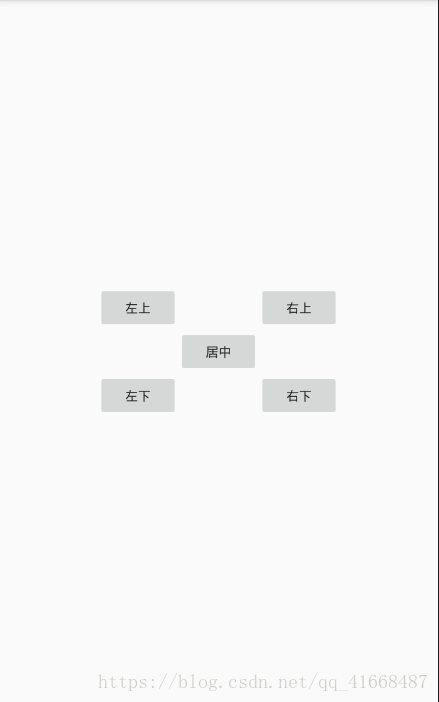
3.FrameLayout 帧布局:
帧布局 布局子视图可以叠加 每一个子视图都是一帧
帧布局的位置摆放只能通过layout_gravity来设置
帧布局是Android系统加载最快的布局
然后我们来简单使用一下帧布局:
<?xml version="1.0" encoding="utf-8"?> <FrameLayout xmlns:android="http://schemas.android.com/apk/res/android" xmlns:tools="http://schemas.android.com/tools" android:id="@+id/activity_main" android:layout_width="match_parent" android:layout_height="match_parent" tools:context="com.example.myapplication.MainActivity"> <View android:layout_width="300dp" android:background="#CA0813" android:layout_gravity="center" android:layout_height="300dp"></View> <View android:layout_width="250dp" android:background="#9ACA27" android:layout_gravity="center" android:layout_height="250dp"></View> <View android:layout_width="200dp" android:layout_height="200dp" android:layout_gravity="center" android:background="#3CB6E3" ></View> <View android:layout_width="150dp" android:layout_height="150dp" android:layout_gravity="center" android:background="#FDBA43"></View> </FrameLayout>
效果图:
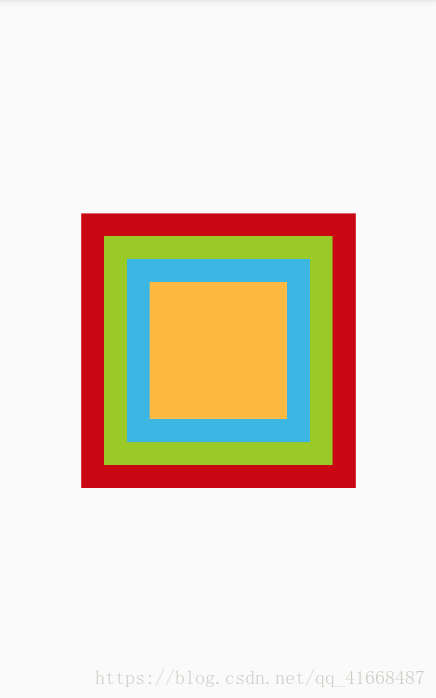
4.AbsolutLayout绝对布局:
开发过程中绝布局是不推荐使用的 它是一种已经过时的布局
子视图通过属性android:layout_x android:layout_y 来确定当前视图在屏幕上的位置
x,y就是坐标点 x轴的值和y轴的值
然后我们来简单使用一下
<?xml version="1.0" encoding="utf-8"?> <AbsoluteLayout xmlns:android="http://schemas.android.com/apk/res/android" xmlns:tools="http://schemas.android.com/tools" android:id="@+id/activity_main" android:layout_width="match_parent" android:layout_height="match_parent" tools:context="com.example.myapplication.MainActivity"> <TextView android:layout_width="wrap_content" android:text="这就是绝对布局" android:layout_x="100dp" android:layout_y="100dp" android:layout_height="wrap_content" /> </AbsoluteLayout>
这就是我们通过layout_X和layout_Y来设置他的位置
效果图:
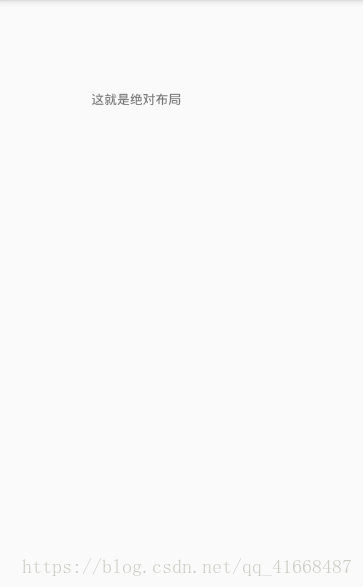
5.TableLayout 表格布局
表格布局类似行和列的形式对控件进行管理
当为TableRow对象时,可在TableRow下添加子控件,默认情况下,每个子控件占据一行.当为View时,该View将独占一行.
TableLayout的行数由开发人员直接指定,即有多少个TableRow对象(或View控件),就有多少行。等于含有最多子控件的TableRow的列数。如第一TableRow含2个子控件,第二个TableRow含3个,第三个TableRow含4个,那么该TableLayout的列数为4.
她的三个列属性是:
android:stretchColumns 设置可伸展的列。该列可以向行方向伸展,最多可占据一整行。
android:shrinkColumns 设置可收缩的列。当该列子控件的内容太多,已经挤满所在行,那么该子控件的内容将往列方向显示。
android:collapseColumns 设置要隐藏的列
我们来简单使用一下
<?xml version="1.0" encoding="utf-8"?> <LinearLayout xmlns:android="http://schemas.android.com/apk/res/android" xmlns:tools="http://schemas.android.com/tools" android:id="@+id/activity_main" android:layout_width="match_parent" android:layout_height="match_parent" android:orientation="vertical" tools:context="com.example.myapplication.MainActivity"> <TableLayout android:stretchColumns="1" android:layout_width="wrap_content" android:layout_height="wrap_content"> <TableRow> <Button android:background="#FFFF00" android:layout_width="70dp" android:layout_height="wrap_content" android:text="按钮1" /> <Button android:layout_marginLeft="5dp" android:background="#FFFF00" android:layout_width="70dp" android:layout_height="wrap_content" android:text="按钮2" /> <Button android:layout_marginLeft="5dp" android:background="#FFFF00" android:layout_width="70dp" android:layout_height="wrap_content" android:text="按钮3" /> <Button android:layout_marginLeft="5dp" android:background="#FFFF00" android:layout_width="70dp" android:layout_height="wrap_content" android:text="按钮4" /> </TableRow> </TableLayout> <TableLayout android:stretchColumns="1" android:layout_width="wrap_content" android:layout_height="wrap_content"> <TableRow> <TextView android:layout_width="70dp" android:layout_height="wrap_content" android:text="按钮1" android:textSize="15sp" /> <TextView android:layout_width="70dp" android:layout_height="wrap_content" android:text="按钮2" android:textSize="15sp" /> <TextView android:layout_width="70dp" android:layout_height="wrap_content" android:text="按钮3" android:textSize="15sp" android:id="@+id/button" /> <TextView android:layout_width="70dp" android:layout_height="wrap_content" android:text="按钮4" android:textSize="15sp" /> </TableRow> </TableLayout> <TableLayout android:stretchColumns="1" android:layout_width="wrap_content" android:layout_height="wrap_content"> <TableRow> <TextView android:layout_width="70dp" android:layout_height="wrap_content" android:text="按钮1" android:textSize="15sp" /> <TextView android:layout_width="70dp" android:layout_height="wrap_content" android:text="按钮2" android:textSize="15sp" /> <TextView android:layout_width="70dp" android:textSize="15sp" android:layout_height="wrap_content" android:text="按钮3" /> <TextView android:layout_width="70dp" android:textSize="15sp" android:layout_height="wrap_content" android:text="按钮4" /> </TableRow> </TableLayout> <TableLayout android:stretchColumns="1" android:layout_width="wrap_content" android:layout_height="wrap_content"> <TableRow> <TextView android:textSize="15sp" android:layout_width="70dp" android:layout_height="wrap_content" android:text="按钮1" /> <TextView android:textSize="15sp" android:layout_width="70dp" android:layout_height="wrap_content" android:text="按钮2" /> <TextView android:textSize="15sp" android:layout_width="70dp" android:layout_height="wrap_content" android:text="按钮3" /> <TextView android:textSize="15sp" android:layout_width="70dp" android:layout_height="wrap_content" android:text="按钮4" /> </TableRow> </TableLayout> </LinearLayout>
效果图:
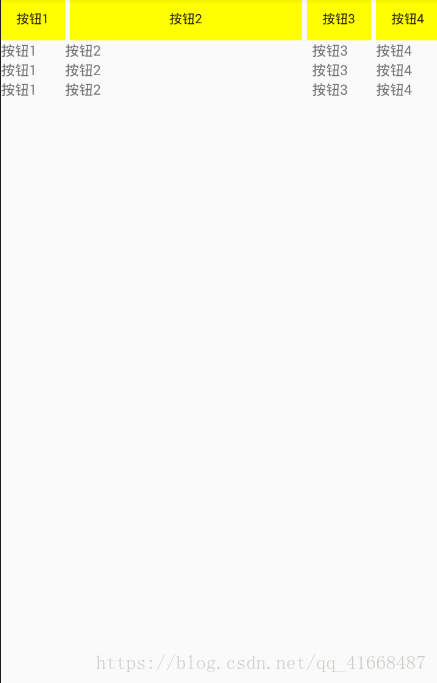
以上就是五大布局







 这篇博客详细介绍了Android Studio中的五大布局——线性布局、相对布局、帧布局、绝对布局和表格布局。线性布局支持水平和垂直排列,相对布局允许视图相对于父布局或兄弟视图定位,帧布局允许子视图叠加,绝对布局通过坐标定位已过时,表格布局则采用行列形式管理控件。
这篇博客详细介绍了Android Studio中的五大布局——线性布局、相对布局、帧布局、绝对布局和表格布局。线性布局支持水平和垂直排列,相对布局允许视图相对于父布局或兄弟视图定位,帧布局允许子视图叠加,绝对布局通过坐标定位已过时,表格布局则采用行列形式管理控件。
















 2131
2131

 被折叠的 条评论
为什么被折叠?
被折叠的 条评论
为什么被折叠?








